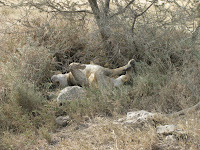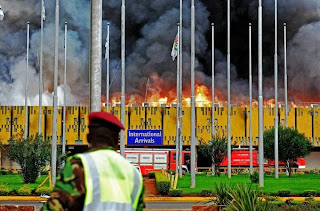Within the vast plains of Serengeti are the kopjes -- rock outlays. It is said that these were in the inspiration for some of the scenery in the "Lion King."
 |
| Being playful |
As we ventured into the park, we came upon 3 lionesses lounging in the shade near the road.
As we ventured further into the park, the roads became rougher; and, the back window in the van broke from the vibration. Luckily, no one was sitting there.
Our next encounter was the hartebeest.
 |
| Can you see all of them! |

 |
 |
| Hello! |
From tall to small -- a dik dik ran across the road. These are the smallest antelopes -- measuring 14-16 inches at the shoulder. They weigh between 10-12 pounds. The males have 3-inch horns. They can run about 26 miles per hour.
Next we came across a group of pregnant zebras. They give birth to one young at a time; and, remarks were made that they were constantly pregnant.
The Serengeti Sopa Lodge is located on a hillside within the park. http://www.sopalodges.com/serengeti-sopa-lodge/overview Animals of all kinds could be seen below our balcony. Our rooms here also included a mosquito net.
During the group discussion of the following days activities, Ed and I decided to opt out of the day's safari. The roads had taken a toll on us, and we were wanting to put some vacation into our trip. We slept in, and when we ventured out of the room, we found that there was only one other guest on the premises. The wait staff brought us a pot of coffee and we enjoyed the view.
We did some laundry and a mother monkey & child were not too pleased when they had to weave between the clothing when crossing our balcony. We joined the group for a late lunch, and then everyone migrated to the swimming pool.
We were enlightened about the adventure that we had missed -- 1) they had seen a kill -- a mother cheetah was teaching her cubs to hunt and 2) they stopped at a rest stop where hippos were in the river nearby. It seems that one of the males had been "kicked out" and he started stomping around the area. The tour guide was quick to tell everyone to find shelter (bathroom/vans) and no one was hurt.
Before dinner we had a group meeting with the tour director. It was hard concentrating when monkeys were situated right above his head. (This is a group photo of the Colorado gang.)
We were up early again the next morning. We traveled back through the Serengeti towards the Crater. We ventured past impalas, zebras, spotted hyenas, and hartebeest.
We came across a pair of cheetahs that were out on a hunt. There was a herd of gazelles close by, but the vans might have distracted them, and they moved on in a different direction. Cheetahs are the fastest land mammal reaching speeds of approximately 75 miles per hour. There can be as many as 8 cubs in a litter -- their mortality rate is highest the first four months due to other predators.
This is the new road
It was at that time that Francis, our tour director, decided to change routes (because the roads had been so rough) and we proceeded in a different direction through the park. We came to a wooden area where there were baboons. Next we were given a pleasant surprise --
We were told by our driver that this was a group of 3 brothers -- the alpha male was the one with the mate. The preferred habitats of African lions are grasslands, savannas, woodlands and scrub. They hunt zebra, wildebeest and buffalo. Lions typically spend about 20 hours a day resting. It is estimated that there are 21,000 wild African lions.
As we continued on towards the park exit, we saw black-backed jackel, elans (the largest of the antelope family), hyena, and elephants. We entered a wooden area and the tsetse (large biting) flies appeared. Luckily we were out of the wooden area before one of the vans had a flat tire. With no air conditioning, we all got out and stretched. One of the drivers stood on top of his van and watched for wild animals while the others fixed the flat.
The next large open area was where the wildebeest came every spring to deliver their babies. The ground here is full of minerals and nutrients after the heavy rains. Once the nutrients have been consumed, the migration north to the Masa River begins.
In the field was the Kori Bustard -- the male is the heaviest bird to fly.
A row of rocks in the road marked the border between the Serengeti and Ngorongoro Parks. Not many tourists enter the Conservation Area via this route. Tourists are often here when the birthing is taking place. The bathroom facilities were an outhouse with holes in the floor.
 |
The Ngorongoro Crater is a large, unbroken, un-flooded caldera, formed when a giant volcano exploded and collapsed some three million years ago. http://www.ngorongorocrater.org/craters.html
The Crater is known to contain over 25,000 large animals, including black rhinocerous, zebras, eland, Grant and Thomson gazelles, wildebeest, flamingos, elephants, mountain reedbuck, Cape buffalo, spotted hyenas, cheetahs, and others. Most of these animals migrate in/out of the crater. The wildebeest, however, are residents and do not venture from the Crater. The Crater has been named as one of the Seven Natural Wonders of the World.
The crater is 20 kilometers (12.4 miles) across, 610 meters (2,000 feet) deep, and covers 260 square kilometers (161.6 square miles). We had the afternoon to explore and see what we could we see. Several of the tour members were not feeling well, so the tour through the Crater was cut short in order to get them to the hotel for observation.
The entrance is a one-way road on one side of the Crater; the roads within the Crater are two-directional; and then another one-way road leads out of the Crater on the other side (this is where our hotel is located.) As we journeyed into the Crater, we saw the Maasai herding their cattle back up the hill. Although the lake in the Crater is salted, there are some fresh watering holes. The drive into the Crater took approximately 20 minutes.
We saw wildebeest, zebra and a Golden jackal as we ventured into the Crater. The first mammal we saw grazing was the warthog. The warthog is a member of the pig family. They are mainly bald with spare hairs and their faces are covered with "warts" which are actually protective bumps. They are primarily grazers and adaptable to go long periods without water.
 |
| Last look at a wildebeest |
We climbed out of the Crater and soon arrived at the Ngorongoro Sopa Lodge situated on the edge of the crater. http://www.sopalodges.com/ngorongoro-sopa-lodge/overview This would be our last night in Africa, as we have a late flight out of Nairobi tomorrow night.
This was one of the colder nights that we had spent here -- we found hot water bottles in our bed.
The last day was long and draining on everyone's nerves. Along with this being the longest distance we would travel, the electrical fuel pump in another van stopped working (trouble seems to come in 3s). They attempted at first to try and pull the van with ours; but, this did not work. So, everyone from that van piled into ours and we headed back to the entrance of the Conservation Area. We waited here while they transported fuel to the immobile van. We made a quick rough trip to Arusha for a late lunch. We then high-tailed it to the border. After passing through both customs, we got aboard a bus that would take us to Nairobi.
It had been planned to give us time at the Ol Serenti to freshen up before our late night flights. But, as the journey went on, and traffic increased, we knew we would be lucky to get to the airport in time. There was a very quick stop at the hotel (to pick up luggage that had been left there), and then we were on our way to the airport. It started raining when we were on the outskirts of Nairobi, so we needed to be dropped off in the rain. Because we had a large group, they did allow us to enter before several of the other travelers.
We got checked in; and, Ed was able to change clothes in the airport bathroom. The group was divided into 3 groups. Because we came through Dubai, we would be departing on Emirates Air. The first department was scheduled an hour before ours; but, we found out when we got home that their flight had been delayed because of mechanical reasons.
When we got to the Dubai Airport, we made a visit to the medical center. Before we departed Nairobi, they had sprayed the inside of the plane. This must have affected Ed's allergies and he wasn't feeling well when we arrived in Dubai. After a check-up and a pill (not sure what exactly), we were on our way to Houston. We had the same excellent service that we had had on our flight out; the 16 hours in flight went by fairly quickly.
When we arrived in Houston, we needed to check through Customs. After going through Customs in three other countries -- this took the longest. We finally gathered our luggage and took it to the holding area for Frontier. Our flight home was delayed, and we were able to catch the flight. Our luggage, however, was delayed and did not reach Fort Collins until the following day.
We saw on the news a week later that the airport in Nairobi had caught fire. We did not hear what was the cause, but it stranded a lot of passengers that had followed us to Africa. We then found out that several of the US embassies throughout Africa had been evacuated due to terrorist threats.
We were thankful that someone above was watching out for us and brought us home safely. Are we glad we did the trip -- Yes!! Would we do it again? -- Probably not by vehicle. Would we recommend it? -- Yes, but do it when you are younger.



















No comments:
Post a Comment